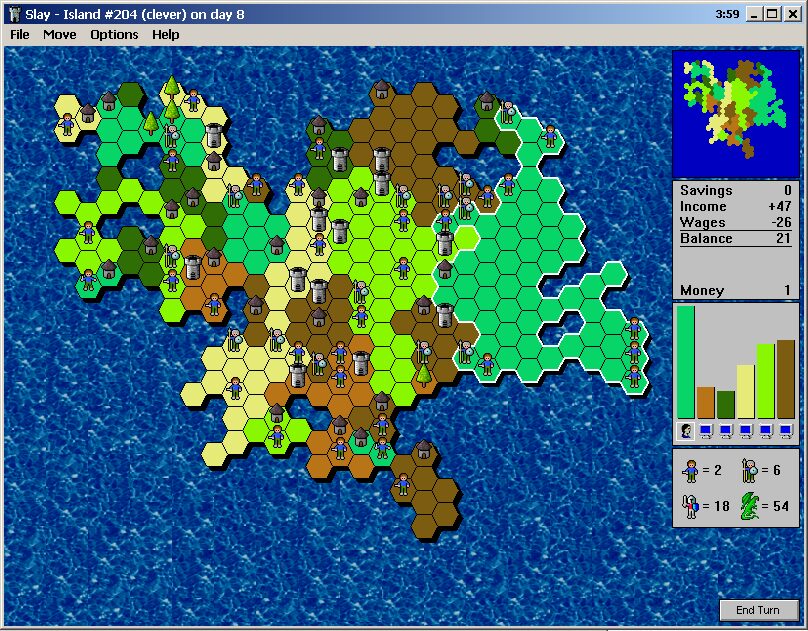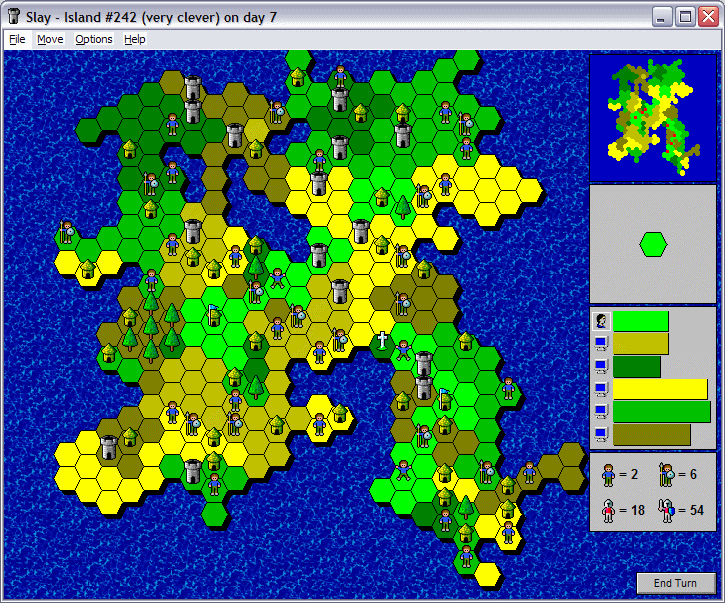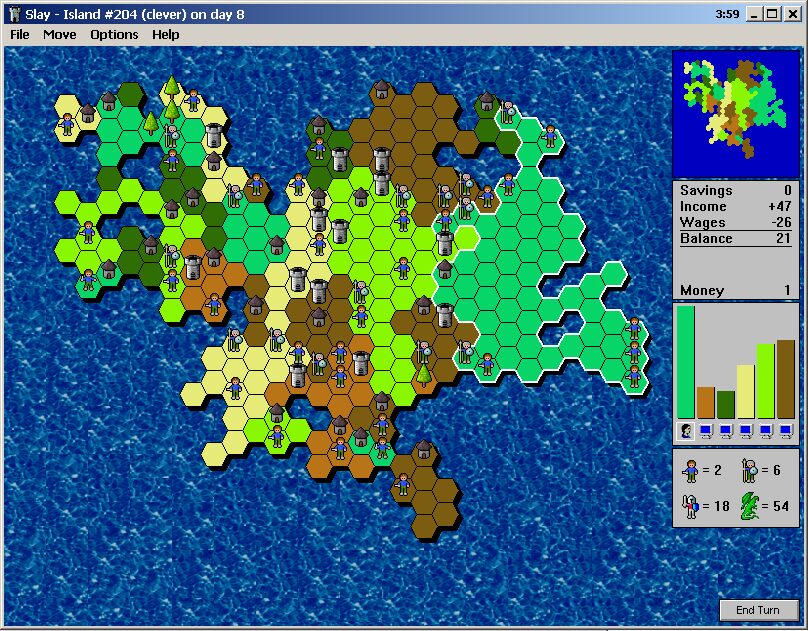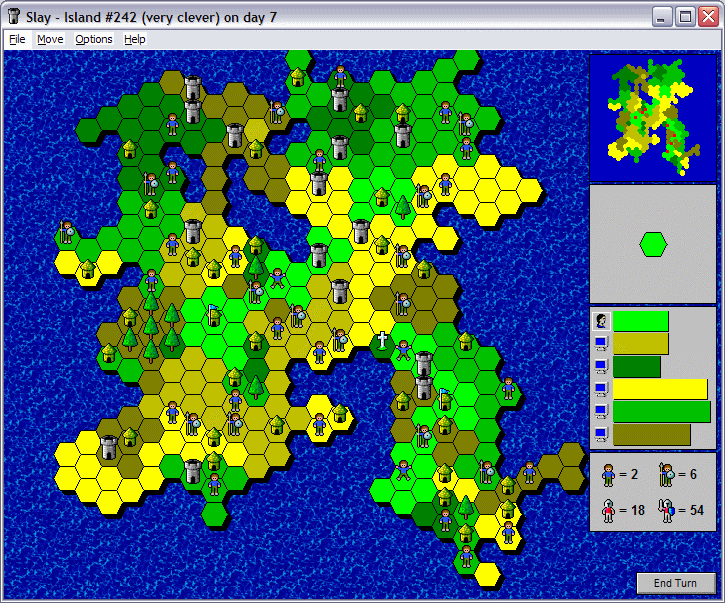Retro Replay Review
Gameplay
Slay delivers a deceptively simple yet deeply strategic turn-based experience set on a hexagonal grid. Each turn, you’ll allocate resources, move troops, and decide whether to press your advantage or consolidate your gains. The core mechanics revolve around recruiting and upgrading four tiers of units—peasants, spearmen, knights, and barons—by merging lesser troops into stronger formations, which adds an elegant layer of tactical depth to even the smallest skirmishes.
(HEY YOU!! We hope you enjoy! We try not to run ads. So basically, this is a very expensive hobby running this site. Please consider joining us for updates, forums, and more. Network w/ us to make some cash or friends while retro gaming, and you can win some free retro games for posting. Okay, carry on 👍)
The game’s focus on divide-and-conquer tactics shines through as you plan your expansions. Early on, peasants can capture neutral cottages and forests, generating gold and food for your war machine. Upgrading to spearmen and knights requires careful resource management: sending too many peasants forward can leave your supply lines exposed, while hoarding troops delays your offensive potential. Balancing offense with defense becomes a constant puzzle as neighboring players jostle for control of key tiles.
Multifront warfare truly tests your ability to prioritize threats. Attack an overextended neighbor, and another rival might seize your weakened lines. The AI opponents exhibit distinct behaviors—some favor aggressive rushes, others turtle behind fortified castles—forcing you to adapt on the fly. This risk-versus-reward tension keeps every turn engaging, whether you’re edging forward one tile at a time or unleashing a baron-led cavalry breakthrough.
Graphics
Visually, Slay embraces a minimalist medieval aesthetic that focuses on clarity over flash. The hexagonal map is rendered with simple, clean lines and muted colors, ensuring that troop icons and resource tiles never get lost in the background. This stripped-down approach makes it easy to see the battlefield at a glance and plan your moves without distraction.
Unit icons are instantly recognizable: peasants as bare-handed figures, spearmen with shields, knights on horseback, and barons distinguished by their ornate banners. While hardcore gamers might crave more intricate animations, the static artwork suits the game’s pacing. Battles are resolved at the end of the turn with quick visual cues, letting you appreciate the ebb and flow of combat without lengthy cutscenes.
The interface is clean and functional. Tooltips explain unit costs, movement range, and upgrade paths with no need to dig through menus. Resource icons for castles, cottages, and forests are intuitive, allowing you to plan expansions efficiently. All of this contributes to a smooth user experience that prioritizes strategy over spectacle.
Story
Slay doesn’t weave an elaborate narrative; instead, it places you directly into the role of a warlord vying for territorial supremacy. The lack of a preordained storyline might feel sparse to players seeking a rich lore, but it also leaves room for emergent stories driven by your own conquests and rivalries. Every campaign unfolds uniquely based on how you exploit the map and respond to enemy maneuvers.
Although there’s no character-driven plot, the medieval theme is palpable. Castles stand as bastions of defense, cottages sprout to bolster your tax base, and forests offer hiding spots for your peasants before they strike. This thematic consistency provides enough context to ground your strategic choices, turning abstract hex tiles into meaningful zones of influence.
Ultimately, Slay’s narrative power is in the sandbox itself. Whether you orchestrate a sweeping baron-led invasion or a stealthy, resource-focused build-up, the ebb and flow of territorial control tells its own tale. This open-ended framework makes each playthrough feel personal, as you craft your own legend on the isle’s contested fields.
Overall Experience
Slay excels at distilling classic turn-based strategy into its purest form. It strips away extraneous features to focus on core mechanics: territory capture, troop upgrades, and resource management. This streamlined design makes it immediately accessible to newcomers while still offering enough depth to satisfy seasoned tacticians.
Replay value is high, thanks to variable map layouts and the unpredictable nature of AI opponents. Every session feels fresh as you explore new opening moves, test different unit compositions, and adapt to shifting alliances. The brisk turn timer keeps the pace lively, turning each skirmish into a quick mental puzzle that’s easy to pick up but hard to master.
For players seeking a budget-friendly strategy title that rewards thoughtful planning over reflexes, Slay is an excellent choice. Its elegant mechanics, combined with a clean interface and enduring challenge, make it a standout option for anyone looking to conquer medieval battlegrounds one hex at a time. Whether you have five minutes or an hour, Slay offers an engaging slice of strategic warfare.
 Retro Replay Retro Replay gaming reviews, news, emulation, geek stuff and more!
Retro Replay Retro Replay gaming reviews, news, emulation, geek stuff and more!








Reviews
There are no reviews yet.